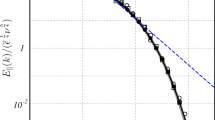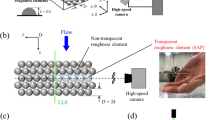Conclusions
-
1.
For all types of roughness the vertical distribution of the average velocities obeys the logarithmic law.
-
2.
The dynamic roughness increases with increase in the geometric roughness.
-
3.
With an increase of relative roughness of the bottom y0/H within limits from 0.5·10−3 to 6.4·10−3 the von Karman constant increases from 0.37 to 0.55 and then it decreases to 0.18.
-
4.
The intensity of turbulence depends linearly on the relative roughness of the bottom.
-
5.
The height of the near-bottom layer, determined from the position of the maximum value of the standard deviation of the longitudinal velocity component, increases with increase in the relative roughness of the bottom.
-
6.
The intensity of the velocity fluctuations increases with increase in the diameter of the roughness projections. Inhomogeneity of the size of the roughness projections promotes an increase in the intensity of pulsations. In the case of a separated arrangement of the roughness projections the pulsation intensity also increases.
-
7.
Channel flow has a layerwise eddy structure. We can assume that the axis of rotation of the eddies occurring near the bottom changes during their penetration into the mass of the flow.
Similar content being viewed by others
Literature Cited
I. K. Nikitin, Turbulent Channel Flow and Processes in the Near-Bottom Region [in Russian], Izd. Akad. Nauk Ukr. SSR, Kiev (1968).
B. A. Fridman, “Effect of wall roughness on the makeup of a turbulent flow,” Izv. Akad. Nauk SSSR,12, No. 3 (1948).
N. B. Mulyukova, D. N. Nabotov, and A. É. Reikhrudel’, “Full-scale investigations of small mountain streams of the Tadzhik SSR,” in: Sediment Transport in Open Channels [in Russian], Nauka, Moscow (1970).
T. V. Aref’eva, G. S. Berlin, N. A. Melekhova, and V. V. Tsvetkova, “Two-component mechanotron transducer for measuring the velocity of a liquid flow,” Izmeritel’. Tekh., No. 1 (1975).
G. S. Berlin and S. A. Rozentul, Mechanotron Transducers and Their Use [in Russian], Énergiya, Moscow (1974).
K. I. Rossinskii, “Bed-load movement,” Trudy Gosudarstvennogo Gidrologicheskogo Instituta, No. 160 (1968).
D. N. Nabotov, “Investigation of the velocity field in the presence of increased bottom roughness,” in: Sediment Transport in Open Channels [in Russian], Nauka, Moscow (1970).
N. A. Mikhailova and D. N. Nabotov, “Investigation of turbulence of a flashy stream with an increased bottom roughness,” Metrologiya i Gidrologiya, No. 5 (1975).
B. A. Fridman, “Energy conversion in a turbulent flow carrying heavy suspended particles,” Izv. Akad. Nauk SSSR, No. 9 (1952).
Additional information
Translated from Gidrotekhnicheskoe Stroitel’stvo, No. 6, pp. 40–44, June, 1976.
Rights and permissions
About this article
Cite this article
Melekhova, N.A., Mikhailova, N.A. & Petrov, V.P. Effect of roughness on the average and pulsating velocity characteristics. Hydrotechnical Construction 10, 595–601 (1976). https://doi.org/10.1007/BF02399220
Issue Date:
DOI: https://doi.org/10.1007/BF02399220




